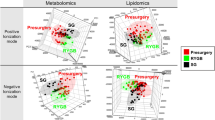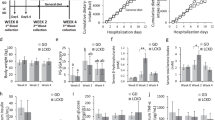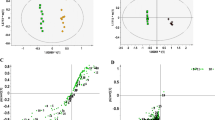Abstract
Background
Ileal transposition (IT) surgery could improve metabolism. Metabolomics has been applied comprehensively in analyzing the global dynamic alterations of metabolites. In the present study, we aimed to investigate serum metabolite alterations in diabetic Goto-Kakizaki (GK) rats after IT surgery.
Methods
Male GK rats were subjected to IT and Sham-IT surgery. Six weeks later, body weight, food intake, fat mass, and serum biochemical parameters were measured. The serum metabolomic fingerprint was analyzed using ultra-performance liquid chromatography–mass spectrometry (LC-MS)-based, non-targeted metabolomic approach. The differential metabolites were identified using principal component analysis and orthogonal partial least squares discriminant analysis. Metabolic pathway analysis was performed using HMDB and KEGG databases.
Results
The body weight, food intake, fat mass, serum levels of glucose and insulin, and homeostasis model assessment of insulin resistance (HOMA-IR) of IT rats were significantly decreased when compared with Sham-IT rats (all P < 0.05). In the metabolomics analysis, ten serum differential metabolites were identified. Compared with Sham-IT rats, serum LysoPC(O-18:0) and PG(20:4/20:0) of IT rats were decreased, while genistein 4′-O-glucuronide, 5,6:8,9-Diepoxyergost-22-ene-3,7beta-diol, PI(16:0/18:2(9Z,12Z)), docosapentaenoic acid, 3-Oxo-4,6-choladienoic acid, 3-Oxocholic acid, and TG were increased. Pathway analysis highlighted the following pathways: ether lipid metabolism, alpha linolenic acid and linolenic acid metabolism, incretin synthesis and secretion, free fatty acid receptors, and biosynthesis of unsaturated fatty acids.
Conclusions
IT surgery could significantly decrease body weight and fat mass and improve glucose metabolism in diabetic GK rats. These beneficial effects might be related to the changes of serum metabolites which involved in lipid metabolism, bile acids, and incretin.




Similar content being viewed by others
References
Dixon JB, le Roux CW, Rubino F, et al. Bariatric surgery for type 2 diabetes. Lancet. 2012;379(9833):2300–11.
Koliaki C, Liatis S, le Roux CW, et al. The role of bariatric surgery to treat diabetes: current challenges and perspectives. BMC Endocr Disord. 2017;17(1):50.
Pok EH, Lee WJ. Gastrointestinal metabolic surgery for the treatment of type 2 diabetes mellitus. World J Gastroenterol. 2014;20(39):14315–28.
Oh TJ, Ahn CH, Cho YM. Contribution of the distal small intestine to metabolic improvement after bariatric/metabolic surgery: lessons from ileal transposition surgery. J Diabetes Investig. 2016;7(Suppl 1):94–101.
Sun X, Zheng M, Song M, et al. Ileal interposition reduces blood glucose levels and decreases insulin resistance in a type 2 diabetes mellitus animal model by up-regulating glucagon-like peptide-1 and its receptor. Int J Clin Exp Pathol. 2014;7(7):4136–42.
Ramzy AR, Nausheen S, Chelikani PK. Ileal transposition surgery produces ileal length-dependent changes in food intake, body weight, gut hormones and glucose metabolism in rats. Int J Obes. 2014;38(3):379–87.
Ikezawa F, Shibata C, Kikuchi D, et al. Effects of ileal interposition on glucose metabolism in obese rats with diabetes. Surgery. 2012;151(6):822–30.
Sun X, Song M, Bai R, et al. Ileal interposition surgery-induced improvement of hyperglycemia and insulin resistance in Goto-Kakizaki rats by upregulation of TCF7L2 expression. Exp Ther Med. 2013;5(5):1511–5.
Culnan DM, Albaugh V, Sun M, et al. Ileal interposition improves glucose tolerance and insulin sensitivity in the obese Zucker rat. Am J Physiol Gastrointest Liver Physiol. 2010;299(3):G751–60.
Cummings BP, Strader AD, Stanhope KL, et al. Ileal interposition surgery improves glucose and lipid metabolism and delays diabetes onset in the UCD-T2DM rat. Gastroenterology. 2010;138(7):2437–46, 2446.e1.
Chelikani PK. Ileal transposition surgery: mechanisms of weight loss and diabetes improvements. In: Faintuch J, Faintuch S, editors. Obesity and diabetes. Cham: Springer; 2015. p. 143–52.
Guo Q, Zhang Q-Q, Chen J-Q, et al. Liver metabolomics study reveals protective function of Phyllanthus urinaria against CCl 4 -induced liver injury. Chin J Nat Med. 2017;15(7):525–33.
Zhao G, Hou X, Li X, et al. Metabolomics analysis of alloxan-induced diabetes in mice using UPLC-Q-TOF-MS after Crassostrea gigas polysaccharide treatment. Int J Biol Macromol. 2018;108:550–7.
Hollywood K, Brison DR, Goodacre R. Metabolomics: current technologies and future trends. Proteomics. 2006;6(17):4716–23.
Gertsman I, Barshop BA. Promises and pitfalls of untargeted metabolomics. J Inherit Metab Dis. 2018;41(3):355–66.
Samczuk P, Ciborowski M, Kretowski A. Application of metabolomics to study effects of bariatric surgery. J Diabetes Res. 2018;2018:6270875.
Liu R, Hong J, Xu X, et al. Gut microbiome and serum metabolome alterations in obesity and after weight-loss intervention. Nat Med. 2017;23(7):859–68.
Zhao L, Ni Y, Yu H, et al. Serum stearic acid/palmitic acid ratio as a potential predictor of diabetes remission after Roux-en-Y gastric bypass in obesity. FASEB J. 2017;31(4):1449–60.
Ashrafian H, Li JV, Spagou K, et al. Bariatric surgery modulates circulating and cardiac metabolites. J Proteome Res. 2014;13(2):570–80.
Lopes TI, Geloneze B, Pareja JC, et al. Blood metabolome changes before and after bariatric surgery: a (1) H NMR-based clinical investigation. OMICS. 2015;19(5):318–27.
Luo P, Yu H, Zhao X, et al. Metabolomics study of Roux-en-Y Gastric Bypass Surgery (RYGB) to treat type 2 diabetes patients based on ultraperformance liquid chromatography–mass spectrometry. J Proteome Res. 2016;15(4):1288–99.
Sarosiek K, Pappan KL, Gandhi AV, et al. Conserved metabolic changes in nondiabetic and type 2 diabetic bariatric surgery patients: global metabolomic pilot study. J Diabetes Res. 2016;2016:3467403.
Nemati R, Lu J, Tura A, et al. Acute changes in non-esterified fatty acids in patients with type 2 diabetes receiving bariatric surgery. Obes Surg. 2017;27(3):649–56.
Yan K, Chen W, Zhu H, et al. Ileal transposition surgery decreases fat mass and improves glucose metabolism in diabetic GK rats: possible involvement of FGF21. Front Physiol. 2018;9:191.
Liu X, Cheng X, Liu X, et al. Investigation of the urinary metabolic variations and the application in bladder cancer biomarker discovery. Int J Cancer. 2018;143(2):408–18.
Kohli R, Kirby M, Setchell KD, et al. Intestinal adaptation after ileal interposition surgery increases bile acid recycling and protects against obesity-related comorbidities. Am J Physiol Gastrointest Liver Physiol. 2010;299(3):G652–60.
Gaitonde S, Kohli R, Seeley R. The role of the gut hormone GLP-1 in the metabolic improvements caused by ileal transposition. J Surg Res. 2012;178(1):33–9.
Nausheen S, Shah IH, Pezeshki A, et al. Effects of sleeve gastrectomy and ileal transposition, alone and in combination, on food intake, body weight, gut hormones, and glucose metabolism in rats. Am J Physiol Endocrinol Metab. 2013;305(4):E507–18.
Yan Z, Chen W, Liu S, et al. Myocardial insulin signaling and glucose transport are up-regulated in Goto-Kakizaki type 2 diabetic rats after ileal transposition. Obes Surg. 2012;22(3):493–501.
Calvo N, Beltran-Debon R, Rodriguez-Gallego E, et al. Liver fat deposition and mitochondrial dysfunction in morbid obesity: an approach combining metabolomics with liver imaging and histology. World J Gastroenterol. 2015;21(24):7529–44.
Jung J, Ha TK, Lee J, et al. Changes in one-carbon metabolism after duodenal-jejunal bypass surgery. Am J Physiol Endocrinol Metab. 2016;310(8):E624–E32.
Friedrich N, Budde K, Fau-Wolf T, et al. Short-term changes of the urine metabolome after bariatric surgery. OMICS. 2012;16(11):612–20.
Kockx M, Kritharides L. Triglyceride-rich lipoproteins. Cardiol Clin. 2018;36(2):265–75.
Arora T, Velagapudi V, Pournaras DJ, et al. Roux-en-Y gastric bypass surgery induces early plasma metabolomic and lipidomic alterations in humans associated with diabetes remission. PLoS One. 2015;10(5):e0126401.
Kaur G, Guo XF, Fau-Sinclair AJ, et al. Short update on docosapentaenoic acid: a bioactive long-chain n-3 fatty acid. Curr Opin Clin Nutr Metab Care. 2016;19(2):88–91.
Flachs P, Rossmeisl M, Fau-Kopecky J, et al. The effect of n-3 fatty acids on glucose homeostasis and insulin sensitivity. Physiol Res. 2014;63(Suppl 1):S93–118.
Hishikawa D, Hashidate T, Fau-Shimizu T, et al. Diversity and function of membrane glycerophospholipids generated by the remodeling pathway in mammalian cells. J Lipid Res. 2014;55(5):799–807.
Shapiro H, Kolodziejczyk AA, Halstuch D, et al. Bile acids in glucose metabolism in health and disease. J Exp Med. 2018;215(2):383–96.
Molinaro A, Wahlstrom A, Marschall HU. Role of bile acids in metabolic control. Trends Endocrinol Metab. 2018;29(1):31–41.
Nauck MA, Meier JJ. Incretin hormones: their role in health and disease. Diabetes Obes Metab. 2018;20(Suppl 1):5–21.
Chen W, Xu Q, Xiao Y, et al. Blockade of central GLP-1 receptors deteriorates the improvement of diabetes after ileal transposition. Int J Med Sci. 2016;13(12):955–62.
Neveu V, Perez-Jimenez J, Vos F, et al. Phenol-explorer: an online comprehensive database on polyphenol contents in foods. Database (Oxford). 2010;2010:bap024.
Yormaz S, Yilmaz H, Ece I, et al. Laparoscopic ileal interposition with diverted sleeve gastrectomy versus laparoscopic transit bipartition with sleeve gastrectomy for better glycemic outcomes in T2DM patients. Obes Surg. 2018;28(1):77–86.
Celik A, Cagiltay E, Ugale S, et al. Diverted sleeve gastrectomy with ileal transposition in overweight, obese, and morbidly obese patients with type 2 diabetes: results of 1-year follow-up. Surg Obes Relat Dis. 2016;12(3):541–9.
Funding
The study was supported by grants from the National Natural Science Foundation of China (No. 81400797 for Weijie Chen, No. 30600836, 81471024 for Huijuan Zhu, No. 30540036, 30771026, 81370898 for Fengying Gong), the Beijing Natural Science Foundation (No. 7082079, 7182130 for Fengying Gong), the National Key Program of Clinical Science (WBYZ2011-873 for Fengying Gong and Huijuan Zhu), and the PUMCH Foundation (2013-020 for Fengying Gong).
Author information
Authors and Affiliations
Corresponding author
Ethics declarations
All animal experimental procedures were approved by the ethics committee of Peking Union Medical College Hospital.
Conflict of Interest
The authors declare that they have no conflict of interest.
Electronic supplementary material
Figure S1
(PDF 120 kb)
Rights and permissions
About this article
Cite this article
Yan, K., Chen, W., Zhu, H. et al. The Changes of Serum Metabolites in Diabetic GK Rats after Ileal Transposition Surgery. OBES SURG 29, 882–890 (2019). https://doi.org/10.1007/s11695-018-3582-4
Published:
Issue Date:
DOI: https://doi.org/10.1007/s11695-018-3582-4




